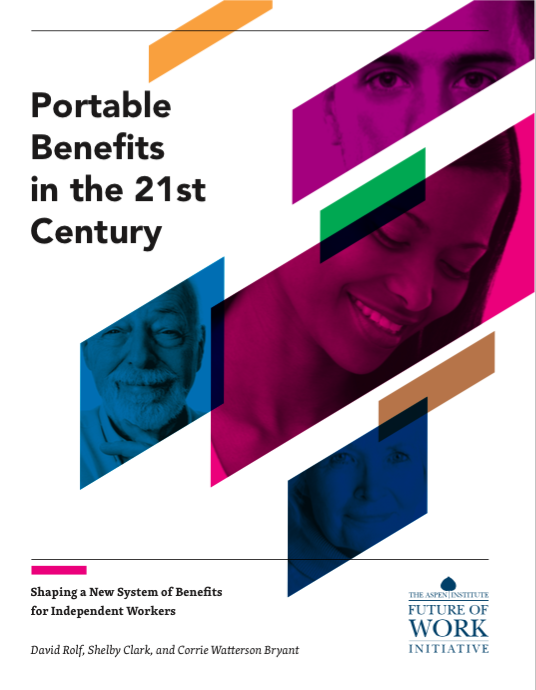Friends with (Portable) Benefits: Shaping a New System with Lessons from Existing Models
As the conversation around Portable Benefits continues to gain momentum, what insights can we take from existing models to inform the potential structure of a Portable Benefits system? A new report for the bipartisan Aspen Institute Future of Work Initiative, entitled “Portable Benefits in the 21st Century: Shaping a New System of Benefits for Independent Workers” aims to answer these questions.

David Rolf, Shelby Clark, and Corrie Watterson Bryant.
We are at a crucial moment in our nation’s history, as a growing number of Americans are working outside of traditional employment. By some counts, there are as many as 54 million freelancers in the United States today. One segment of the freelance workforce may be growing particularly rapidly: The “on-demand economy” (including platforms like Uber, Lyft, and Handy). The on-demand workforce expanded 47 fold from 2012 to 2015 alone, according to a study by JP Morgan Chase. Yet all is not rosy in the land of the free: these workers are excluded from the social safety net provided by traditional employment — a package of benefits that usually includes workers compensation, unemployment, paid leave, health care, and retirement.
In November 2015, an unlikely collaboration of roughly 40 individuals and organizations from across the political spectrum made a call for a system of “Portable Benefits” as a way to extend our social safety net to millions of independent workers. The call for Portable Benefits springs from the recognition that workers should not lose the protections of traditional employment as work shifts to more flexible arrangements in the new economy.
The idea has captured the attention of policymakers, labor leaders, and CEOs from gig economy platforms. In recent months, support for Portable Benefits has continued to grow. Hillary Clinton endorsed the idea in July 2015, saying that “we need to make sure people have access to benefits and that they are portable as they move from job to job.” President Obama called for portable benefits in his State of the Union address. Uber recognized a new worker association called the Independent Drivers Guild, which will advocate for drivers and aims to establish a Portable Benefits system. And last month, Sen. Elizabeth Warren, D-Massachusetts, called for portable benefits for the contingent workforce in a speech at New America’s annual conference.
Building off this momentum, we authored a new report for the bipartisan Aspen Institute Future of Work Initiative, entitled “Portable Benefits in the 21st Century: Shaping a New System of Benefits for Independent Workers”. The report coalesces ideas from the growing Portable Benefits conversation, and identifies lessons learned from five existing benefits models to inform the potential design of a new system for independent workers. We’ve summarized a few key ideas below, but click here to read the whole report.
While there are many open conversations regarding a potential Portable Benefits structure, most envision the system to contain three core tenets:
● Portable: Workers’ benefits are not tied to any particular job or company; they own their own benefits.
● Pro-rated: Each company contributes to a worker’s benefits at a fixed rate depending on how much he or she works, or earns.
● Universal: Benefits cover independent workers, not just traditional employees.
Unresolved questions about a system of Portable Benefits include: Which benefits would be included? Who would pay and how much? How could the funds be administered? And, which regulations and policies could enable or require such a system? To get a handle on these questions, we explored lessons learned from similar models, including:
1. Multiemployer plans: Responsibility for providing benefits can be shared among multiple employers.
2. Black Car Fund: Benefits can be delivered to independent contractors when mandated by law, and can be funded by an industry-wide fee paid by customers.
3. Ghent System: Offering insurance through voluntary worker organizations can serve as an effective mechanism to build economic power for workers.
4. Group Insurance: Group insurance can be provided for individual independent contractors, much as the AARP offers inexpensive group life insurance to its members.
5. SecureChoice Retirement plans: Emerging state-based retirement plans can deliver new retirement options for independent contractors.
Perhaps the most instructive model is the Black Car Fund, which mandates a 2.5% transaction fee to provide independent drivers with workers compensation. The Fund currently delivers workers compensation coverage for Lyft, Uber, and taxi drivers in New York. Since collecting the fee is mandatory for all companies, it has not been considered as a factor in employment classification, addressing the common concern of on-demand companies. The Black Car Fund model, if implemented as a geographic or industry-wide mandate, could provide an effective mechanism of collecting pro-rata contributions from multiple companies.
Action is needed to ensure that our nation’s large and growing population of independent workers is able to access the benefits and protections that were critical to building a strong American middle class. Though we recognize that many unanswered questions remain, it is crucial for policymakers and worker advocates to acknowledge that the new economy is here to stay and that the systems that work best for the future will be those that nimbly adapt to these realities.
For a more in depth reviews of these concepts, please click here to read the entire report. We hope that this report serves as a tangible step toward developing a viable framework for a system of Portable Benefits, but we also welcome any and all to add to the conversation. Please feel free to add your thoughts below or start a related post to keep the ideas developing, and check back for more ideas the Future of Work Initiative will be publishing on these topics over the next few months.

